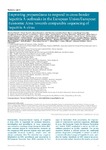Improving preparedness to respond to cross-border hepatitis A outbreaks in the European Union/European Economic Area: towards comparable sequencing of hepatitis A virus
Enkirch, Theresa
Severi, Ettore
Vennema, Harry
Thornton, Lelia
Dean, Jonathan
Borg, Maria-Louise
Ciccaglione, Anna Rita
Bruni, Roberto
Christova, Iva
Ngui, Siew Lin
Balogun, Koye
Němeček, Vratislav
Kontio, Mia
Takács, Mária
Hettmann, Andrea
Korotinska, Rita
Löve, Arthur
Avellón, Ana
Muñoz-Chimeno, Milagros
de Sousa, Rita
Janta, Denisa
Epštein, Jevgenia
Klamer, Sofieke
Suin, Vanessa
Aberle, Stephan W.
Holzmann, Heidemarie
Mellou, Kassiani
Lundberg Ederth, Josefine
Sundqvist, Lena
Roque-Afonso, Anne-Marie
Kurečić Filipović, Sanja
Poljak, Mario
Vold, Line
Stene-Johansen, Kathrine
Midgley, Sofie
Kølsen Fischer, Thea
Faber, Mirko
Wenzel, Jürgen J.
Takkinen, Johanna
Leitmeyer, Katrin
Introduction
Sequence-based typing of hepatitis A virus (HAV) is important for outbreak detection, investigation and surveillance. In 2013, sequencing was central to resolving a large European Union (EU)-wide outbreak related to frozen berries. However, as the sequenced HAV genome regions were only partly comparable between countries, results were not always conclusive.
Aim
The objective was to gather information on HAV surveillance and sequencing in EU/European Economic Area (EEA) countries to find ways to harmonise their procedures, for improvement of cross-border outbreak responses.
Methods
In 2014, the European Centre for Disease Prevention and Control (ECDC) conducted a survey on HAV surveillance practices in EU/EEA countries. The survey enquired whether a referral system for confirming primary diagnostics of hepatitis A existed as well as a central collection/storage of hepatitis A cases’ samples for typing. Questions on HAV sequencing procedures were also asked. Based on the results, an expert consultation proposed harmonised procedures for cross-border outbreak response, in particular regarding sequencing. In 2016, a follow-up survey assessed uptake of suggested methods.
Results
Of 31 EU/EEA countries, 23 (2014) and 27 (2016) participated. Numbers of countries with central collection and storage of HAV positive samples and of those performing sequencing increased from 12 to 15 and 12 to 14 respectively in 2016, with all countries typing an overlapping fragment of 218 nt. However, variation existed in the sequenced genomic regions and their lengths.
Conclusions
While HAV sequences in EU/EEA countries are comparable for surveillance, collaboration in sharing and comparing these can be further strengthened.

